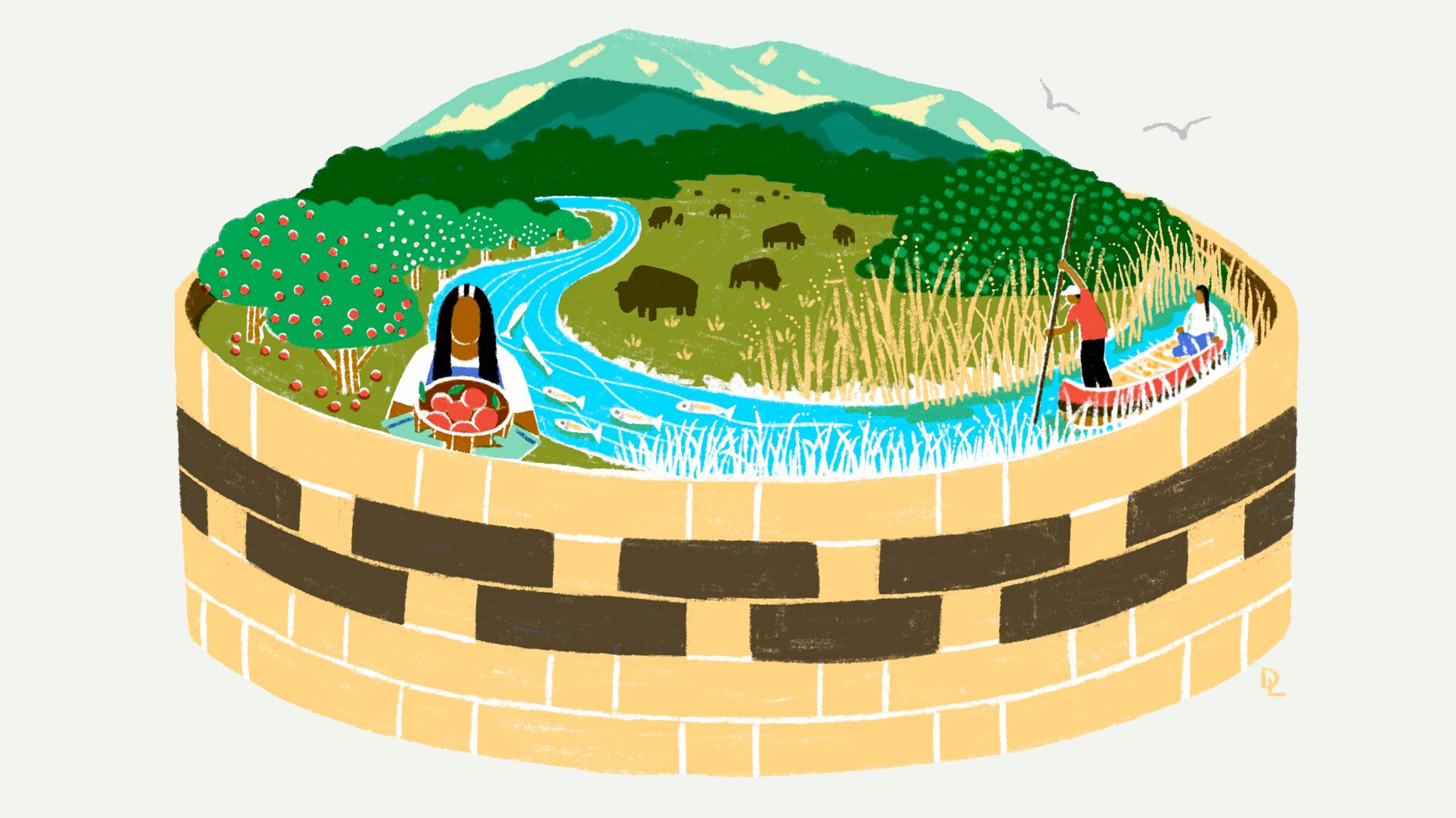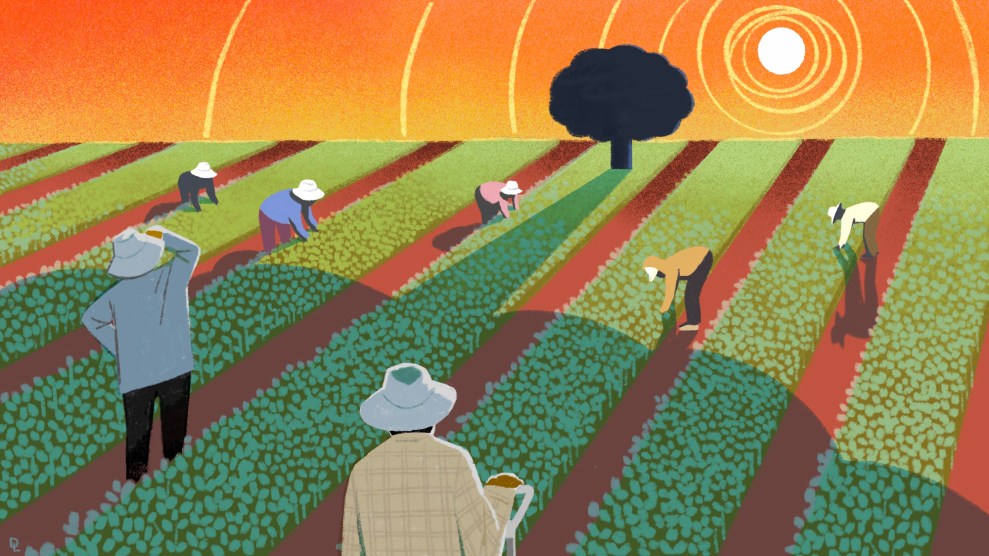The farm bill is one of the most important but least understood pieces of US legislation, and it’s overdue for renewal. But Congress couldn’t pass a new version in the fall, reflecting partisan dysfunction and also a contentious debate about what the bill ought to be—a debate that has become ensnared in the nation’s culture wars. Racial equity, food sovereignty, protections for workers, and meaningful action on climate change have broadened the bill’s traditional mandate of growing food and feeding hungry people. In this special series, a partnership with the Food and Environment Reporting Network, we’ll be exploring some of the urgent issues a new farm bill must address. Read the other stories in the series here.
For years, the Oneida Nation has been growing crops and raising cattle and buffalo on its 65,000-acre reservation near Green Bay, Wisconsin. Now, some of that food is doing more than nourishing people: It’s helping undo centuries of government overreach. As part of a pilot program included in the 2018 farm bill, the tribe is using federal dollars to buy food grown on the reservation and distributing it for free to low-income members of its tribe and another, the Menominee Indian Tribe of Wisconsin.
The program has given the tribe more say over the meals the federal government provides to low-income people on its reservation. And it has bolstered markets for local producers, says Vanessa Miller, the food and agriculture area manager for the tribe. Food sovereignty, which includes people’s right to healthy and culturally appropriate food and the right to define their own food and agriculture systems, is inherent to tribes, Miller says: “This is all rooted in our identity as Oneida people. We’re empowering our communities and ourselves by taking our health into our own hands.”
Over the past two centuries, the reservation system and other federal policies devastated many tribes’ food systems, disrupting their hunting, fishing, farming, and harvesting traditions. Today, about one in four Native Americans receives some kind of federal food assistance. For a long time, this consisted of “dumped food from a faceless and uncaring federal government,” said Mary Greene-Trottier, a member of the Spirit Lake Sioux nation who manages FDPIR on her reservation and leads a group of tribal members that advise the USDA on the program, in testimony before a House subcommittee in 2021. Tribes received foods like lard and wheat flour that were foreign to their diets and that sometimes arrived “rancid and rotten,” according to a report commissioned by the American Heart Association.
Tribal nations have for decades worked to reassert authority over their food systems. But those efforts got little support from the farm bill. That changed in the lead-up to 2018, when tribal governments, Native American farmers and ranchers, and advocates pushed for a farm bill that would, for the first time, reflect their priorities and respect tribes’ inherent sovereignty. The coalition made important inroads: 63 provisions in the 2018 legislation directly address tribal nations. One of the most important was the pilot program the Oneida Nation is taking part in.
That pilot, called—rather paternalistically—the Food Distribution Program on Indian Reservations (FDPIR) Self-Determination Demonstration Project, is up for renewal during this farm bill cycle. FDPIR is a larger program that was created in 1977 as a counterpart to SNAP, formerly known as food stamps. Like all income-eligible Americans, tribal members can enroll in SNAP and use it to buy food at grocery stores. But the remote location of many reservations can make it hard to use these benefits. FDPIR, which arrives as a monthly allotment of food, was meant as an alternative. In some places, tribal citizens can get food boxes delivered to their homes, while in others they choose from provisions arranged as they would be in a grocery store. FDPIR, which cost about $100 million last year, delivers food to up to 85 percent of people living on some reservations.
In the early days, the program offered mainly the salt-, fat-, and sugar-laden commodity foods that drive chronic disease, though due to pressure from tribes the selection has improved somewhat over the years to include more fresh produce and a handful of culturally important foods, like buffalo meat and wild rice. Yet the federal government still decides what foods it will distribute, and it makes its own purchasing agreements with producers, a system that favors large-scale vendors. That’s led to missed opportunities for Native American farmers—especially when the USDA buys traditional foods, like blue corn, from non-Native producers. And there are still problems with quality—it’s not uncommon for produce to travel long distances and arrive spoiled, and many foods that are traditional to certain tribes are still unavailable.
The pilot project, attempting to fix some of these lingering issues, has since October 2021 given 16 tribes in nine states $10.1 million to source some of the ingredients that FDPIR provides.
Producing their own food is critical to the Oneida Nation’s economic security and the health of its citizens, Miller says. By revitalizing its food system, the tribe can help its people physically reconnect to their land and culture and recover from the historical trauma caused by federal policies.
Through the self-determination pilot, the Oneida and the Menominee of Wisconsin have used federal funds to buy apples, buffalo meat, beef, wild rice, and fish from local Native producers and distribute the food to tribal members enrolled in FDIPR. Similarly, the Alaska Native Tribal Health Consortium swapped out USDA-procured walleye and catfish for locally caught halibut and cod. And the Tohono O’odham Nation, in Arizona, replaced processed foods like USDA-bought cornflakes and dehydrated potatoes with Native-grown products like wheat berries and tepary beans, which are indigenous to their homeland in the American Southwest.
The self-determination pilot, while small, has been a success, Miller says. People appreciate the higher quality of the food and the fact that it comes from local, Indigenous producers. It has also created a stable new market for farmers and ranchers. Already the Oneida farm is making plans to expand its herds.
And the pilot has had broader ripple effects. Tribes have been pushing for much wider latitude over USDA programs, and the success of the pilot bolsters their case. Groups such as the Native Farm Bill Coalition want the next farm bill to authorize tribal governments to administer SNAP and other nutrition assistance programs, meat inspections, and conservation programs on their own lands. Granting that authority would go a long way toward advancing tribal sovereignty, Miller argues.
It would also make these programs more efficient, since it would let tribal governments decide how funds are spent and how programs should run, based on their communities’ needs and priorities.
“When the same people who are administering the program are experiencing the community issues, you’re a closer resource,” Miller says. “You’re the boots on the ground.”
Efforts to grant tribes more authority over USDA programs have some bipartisan support. In July, Sen. Tina Smith, a Democrat from Minnesota, and Sen. John Hoeven, a Republican from North Dakota, introduced the FDPIR Tribal Food Sovereignty Act, which would give tribal governments authority to administer the entire FDPIR program. Working with Republican counterparts, Smith has also introduced bills that would let tribes inspect their own meat and administer SNAP. The USDA has since 2021 also supported Native food systems through its Food Sovereignty Initiative, which works with tribes to “reimagine federal food and agriculture programs from an Indigenous perspective.”
Giving tribes more control over the way the federal government operates in their territory and in their affairs isn’t a new idea. Since the 1970s, tribes have entered into hundreds of self-determination and self-governance contracts with other federal agencies. Tribes run entire health systems. Half of the Department of the Interior’s budget is now administered by tribal authorities, as is about 60 percent of the Indian Health Services’ budget, according to the Indigenous Food and Agriculture Initiative.
But the FDPIR Self-Determination pilot was the first time that the door to self governance at the USDA has been cracked even slightly open. Giving tribal nations more say over what they produce and eat is “both an opportunity and obligation for the federal government,” Richard Chalyee Éesh Peterson, the chair of the Tlingit and Haida Indian Tribes of Alaska, said at a Senate Committee on Indian Affairs hearing in July. “Self-governance and the co-management that can go hand in hand with it are not gifts to tribes. They are a recognition that the federal government cannot and does not have the right to tell our history upon our homelands or to shape the future of this place without us at the table.”
To create truly meaningful change, the farm bill should go beyond the pilot program, argues Jay Spaan, the executive director of the Self-Governance Communication and Education Tribal Consortium, a Tulsa-based nonprofit. Spaan has called for the creation of a USDA Office of Self-Governance, which would function as a single point of contact for tribes that want to take more control over federal programs, ranging from rural broadband to crop insurance to food assistance.
Such an office would also force the agency to develop, for the first time, its capacity to negotiate agreements with tribes about food and agriculture in a government-to-government manner. Federal agencies have often been somewhat hesitant, at the start, to enter into such agreements with tribes, says Spaan, who senses this reluctance, now, from the USDA. “Agencies are always, like, ‘Oh, I don’t know how the tribes could do this,'” Spaan says. He finds this sort of resistance “hilarious,” since tribes are already operating other multi-million-dollar programs, including huge health systems, through agreements with other federal agencies—“I’m pretty sure they can administer SNAP.”

















